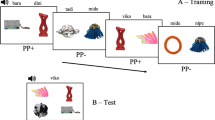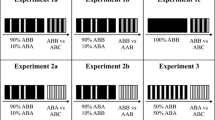Abstract
Many English phonemes have more than one possible spelling. People’s choices among the options may be influenced by sublexical patterns, such as the identity of neighboring sounds within the word. However, little research has explored the possible role of lexical conditioning. Three experiments examined the potential effects of one such factor: whether an item is typical of English or atypical. In Experiment 1, we asked whether presenting pseudowords as made-up words or the names of monsters would cause participants to classify them as atypical and spell phonemes within these pseudowords using less common patterns. This was not found to be the case in children (aged 7–12 years) or adults. In Experiment 2, children aged 10–12 and adults spelled pseudowords that contained phonologically frequent or infrequent sequences and, in Experiment 3, adults chose between two possible spellings of each of these pseudowords. Adults, but not children, used more common spellings in pseudowords that contained frequent sequences and that thus seemed more typical of English. They used fewer common spellings in pseudowords that contained infrequent sequences and therefore seemed atypical. These results suggest that properties of pseudowords themselves can affect lexical classification and hence spelling.
Similar content being viewed by others
References
Albrow, K. H. (1972). The English writing system: Notes towards a description. London: Longman.
Bates, D., Maechler, M., & Bolker, B. (2011). lme4: Linear mixed-effects models using S4 classes. R package version 0.999375-41. http://CRAN.R-Project.org/package=lme4.
Carney, E. (1994). A survey of English spelling. London: Routledge.
Hayes, H., Treiman, R., & Kessler, B. (2006). Children use vowels to help them spell consonants. Journal of Experimental Child Psychology, 94, 27–42. doi:10.1016/j.jecp.2005.11.001.
Juul, H. (2005). Knowledge of context sensitive spellings as a component of spelling competence: Evidence from Danish. Applied Psycholinguistics, 26, 249–265. doi:10.1017/S0142716405050162.
Kohler, C. T., Bahr, R. H., Silliman, E. R., Bryant, J. B., Apel, K., & Wilkinson, S. C. (2007). African American English dialect and performance on nonword spelling and phonemic awareness tasks. American Journal of Speech-Language Pathology, 16, 157–168. doi:10.1044/1058-0360(2007/020.
Martin, D. H., & Barry, C. (2012). Writing nonsense: The interaction between lexical and sublexical knowledge in the priming of nonword spelling. Psychonomic Bulletin & Review, 19, 691–698. doi:10.3758/s13423-012-0261-7.
Mitchell, P., Kemp, N., & Bryant, P. (2011). Variations among adults in their use of morphemic spelling rules and word-specific knowledge when spelling. Reading Research Quarterly, 46, 119–133. doi:10.1598/RRQ.46.2.2.
Pacton, S., Fayol, M., & Perruchet, P. (2005). Children’s implicit learning of graphotactic and morphological regularities. Child Development, 76, 324–339. doi:10.1111/j.1467-8624.2005.00848_a.x.
Pacton, S., Sobaco, A., Fayol, M., & Treiman, R. (2013). How does graphotactic knowledge influence children’s learning of new spellings? Frontiers in Psychology, 4, 1–10. doi:10.3389/fpsyg.2013.00701.
Pollo, T. C., Kessler, B., & Treiman, R. (2009). Statistical patterns in children’s early writing. Journal of Experimental Child Psychology, 104, 410–426. doi:10.1016/j.jecp.2009.07.003.
Ritchey, K. D. (2008). The building blocks of writing: Learning to write letters and spell words. Reading and Writing: An Interdisciplinary Journal, 21, 27–47. doi:10.1007/s11145-007-9063-0.
Treiman, R., & Kessler, B. (2006). Spelling as statistical learning: Using consonantal context to spell vowels. Journal of Educational Psychology, 98, 642–652. doi:10.1037/0022-0663.98.3.642.
Treiman, R., & Kessler, B. (2014). How children learn to write words. New York, NY: Oxford University Press.
Treiman, R., Kessler, B., & Bick, S. (2002). Context sensitivity in the spelling of English vowels. Journal of Memory and Language, 47, 448–468. doi:10.1016/S0749-596X(02)00010-4.
Treiman, R., Kessler, B., & Evans, R. (2007). Anticipatory conditioning of spelling-to-sound translation. Journal of Memory and Language, 56, 229–245. doi:10.1016/j.jml.2006.06.001.
Treiman, R., Kessler, B., Knewasser, S., Tincoff, R., & Bowman, M. (2000). English speakers’ sensitivity to phonotactic patterns. In M. B. Broe & J. B. Pierrehumbert (Eds.), Papers in laboratory phonology V: Acquisition and the lexicon (pp. 269–282). Cambridge: Cambridge University Press.
Acknowledgments
We thank Brad Mertens for help with the third experiment, and we are grateful to all of the child and adult participants for participating in our tasks.
Author information
Authors and Affiliations
Corresponding author
Appendix: Spelling items used in experiments
Appendix: Spelling items used in experiments
Experiment 1
List 1 /ˈʃɪgɔs/, /ˈʃɛləp/, /ˈwufɛks/, /ˈwɪnək/, /ˈzɛlkoʊ/, /ˈzæθɔ/, /ˈsɛfrəd/, /səˈbʊl/, /ˈgæraɪb/, /ˈgɛpɒnt/, /ˈhoʊti/, /ˈhubəm/, /ˈfævɔk/, /ˈfɪmɒʃ/, /ˈkɜmaɪd/, /ˈkɒlaɪt/, /ˈrɪlkəm/, /ˈraɪkɒb/, /ˈnɑpəl/, /ˈnɔbaɪd/
List 2 /ˈʃænəks/, /ˈʃɪklən/, /ˈwɛmpət/, /ˈwɪbloʊ, /ˈzæbɪk/, /ˈzimɔt/, /ˈsɪldən/, /səˈroʊb/, /ˈgɛmboʊ, /ˈgɑtni/, /ˈhɔflət/, /ˈhumɑp/, /ˈfæpni/, /ˈfrɛləp/, /ˈkɜpəm/, /ˈkroʊgɜt/, /ˈrɛθəm/, /ˈraɪgɒks/, /ˈnɔbɒk/, /ˈnaɪbət/
List 3 /ˈʃæpwɒn/, /ˈʃɛnoʊ/, /ˈwulɒd/, /ˈwɛpi/, /ˈzifəm/, /ˈzɛnθi/, /ˈsɛmbi/, /ˈsɪdoʊn/, /ˈgæntəp/, /ˈgɑmoʊn/, /ˈhɔʃənt/, /ˈhoʊkwəl/, /ˈfɪkməl/, /ˈfreɪstæf/, /ˈkɒnɑd/, /ˈkraɪkwɒn/, /ˈrɪnwʊl/, /ˈrɛmpi/, /ˈnaɪzɛk/, /ˈnɑkut/
Filler real words Adults: motet, trestle, pithy, elfin, children: morsel, tassel, poncho, erode
Filler pseudowords /ˈmɛfəl/, /ˈtraɪbɒk/, /ˈpræbəl/, /ˈivɒp/, /ˈmɜnəm/, /ˈtʌləb/, /ˈpɪdwɒn/, /ˈɛlpɒn/
Experiments 2 and 3
Initial target, typical /wɛsp/, /wɪlk/, /wɛmp/, /wæsk/, /krɒnt/, /kɒsp/, /klɛŋk/, /krʌsp/, /frʌntʃ/, /fæsp/, /fɪlt/, /fæmp/, /ʃɛnt/, /ʃɛlk/, /ʃɪŋk/, /ʃæmp/
Initial target, atypical /wɛʃp/, /wɪfk/, /wɛmv/, /wæsf/, /krɒnv/, /kɒfp/, /klɛʃk/, /krʌfp/, /frʌnv/, /fæθp/, /fɪʒt/, /fæmʃ/, /ʃɛnf/, /ʃɛlʒ/, /ʃɪfk/, /ʃæʃp/
Final target, typical /glɛf/, /blɪf/, /brɒf/, /plʌf/, /brɛk/, /spʌk/, /stræk/, /plɪk/, /grætʃ/, /stɒtʃ/, /plɪtʃ/, /prɛtʃ/, /flɛl/, /twɛl/, /brʌl/, /prɪl/
Final target, atypical /ʃlɛf/, /bwɪf/, /vrɒf/, /pwʌf/, /bwɛk/, /ʃpʌk/, /sklæk/, /vlɪk/, /vrætʃ/, /sfɒtʃ/, ʃlɪtʃ/, /pwɛtʃ/, /ʃlɛl/, /nwɛl/, /bwʌl/, /zrɪl/
IPA symbols used in spelling items and examples of each phoneme from Australian English
IPA | Example | IPA | Example | IPA | Example |
|---|---|---|---|---|---|
Consonants | |||||
p | p as in pin | f | f as in fin | h | h as in hit |
b | b as in bin | v | v as in van | m | m as in met |
t | t as in tin | θ | th as in thin | n | n as in net |
d | d as in din | s | s as in sin | l | l as in let |
tʃ | ch as in chin | z | z as in zone | r | r as in rot |
k | k as in kin | ʃ | sh as in shin | w | w as in wet |
g | g as in gone | ʒ | s as in vision | ||
Vowels | |||||
æ | a as in pat | ɪ | i as in pit | ʌ | u as in pun |
ɑ | a as in part | i | i as in peat | ʊ | u as in put |
ɒ | o as in pot | eɪ | a as in plate | u | oo as in spoon |
ɔ | or as in port | ɛ | e as in pet | aɪ | i as in pine |
ə | a as in about | ɜ | er as in pert | oʊ | o as in post |
Rights and permissions
About this article
Cite this article
Kemp, N., Treiman, R., Blackley, H. et al. Lexical classification and spelling: Do people use atypical spellings for atypical pseudowords?. Read Writ 28, 1187–1202 (2015). https://doi.org/10.1007/s11145-015-9567-y
Published:
Issue Date:
DOI: https://doi.org/10.1007/s11145-015-9567-y




